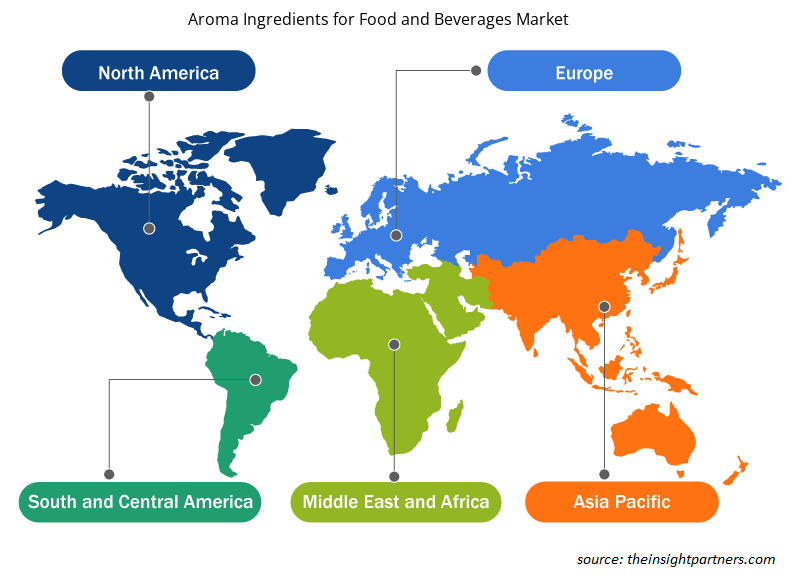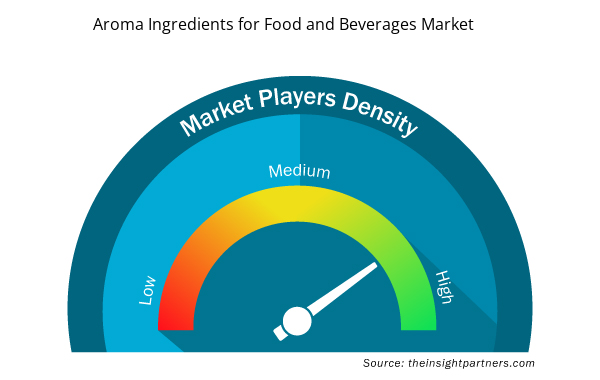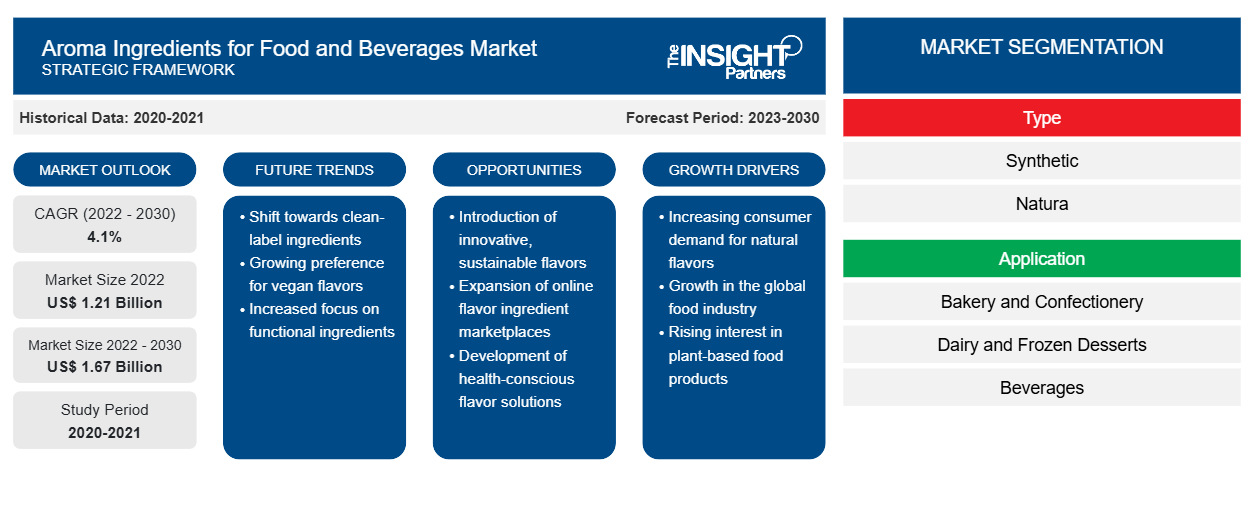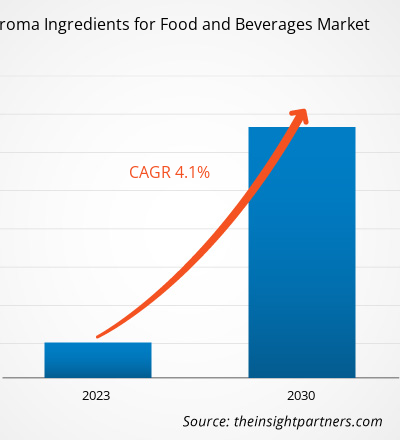[研究报告] 食品和饮料芳香剂市场规模预计将从 2022 年的 12.1 亿美元增长到 2030 年的 16.7 亿美元;预计 2022 年至 2030 年市场复合年增长率为 4.1%。
市场洞察和分析师观点:
芳香成分是从天然来源的成分中分离出来的,或通过化学方法从石油中提取出来的。这些成分在塑造各种食品和饮料的风味和香气方面起着至关重要的作用,从糖果和咸味小吃到酒精和非酒精饮料。芳香成分在食品和饮料行业中日益增长的重要性以及主要市场参与者的战略举措是推动食品和饮料市场芳香成分发展的主要因素。此外,消费者对独特和异国风味和香气体验的需求不断增加,以及提取和合成技术的进步,进一步有助于塑造市场格局。然而,食品和饮料行业使用芳香成分的监管限制阻碍了食品和饮料市场芳香成分的增长。
增长动力和挑战:
食品和饮料行业的芳香成分制造商大量参与并购、合作和其他战略发展,以吸引消费者并提升其市场地位。生产和销售烘焙和糖果、乳制品、冷冻甜点和其他产品的各种食品和饮料企业对芳香成分的需求不断增加,这促使主要参与者采取战略举措来加强其全球市场地位。例如,2023 年 11 月,巴斯夫 SE 宣布推出两种新的天然芳香成分:Isobionics Natural alpha-Bisabolene 98 和 Isobionics Natural (-)-alpha-Bisabolol 99。此类产品开发正在推动食品和饮料市场的芳香成分。
市场的主要参与者正在扩大生产设施并与分销商达成协议,以加强其市场地位。例如,2021 年 12 月,Tilley Distribution, Inc. 宣布与 Phoenix Aromas and Essential Oils 合并。合并将有助于为新老消费者群体提供高质量的产品,并拥有经验丰富的监管和技术支持团队。此外,2021 年 7 月,Symrise AG 收购了总部位于加拿大的 Giraffe Foods Inc.,这是一家为 B2B 客户定制酱汁、蘸料、调味品、糖浆和饮料浓缩液的加拿大生产商。此次收购将扩大 Symrise 在北美的风味和营养部门,提升其市场地位和客户群。因此,主要市场参与者的战略举措推动了全球食品和饮料芳香成分市场的增长。
各种政府机构对各种食品和饮料中芳香成分的生产和使用进行监管。美国食品药品管理局 (FDA) 和欧洲食品安全局 (EFSA) 等监管机构对芳香成分的使用制定了严格的准则和标准,以确保消费者安全和产品质量。例如,联合国环境规划署对食品芳香剂的使用进行了监管。该法规规定了在食品中正确、可控和安全地使用调味剂和芳香成分或芳香剂的所有必要条件。此外,美国食品药品管理局 (FDA) 还对可用于食品内外的食品芳香剂制定了法规。满足这些监管要求需要进行大量的测试和文档处理,这对制造商来说可能非常耗时且成本高昂。芳香成分的审批过程可能漫长而复杂,进一步阻碍了行业内的创新和产品开发。
定制此报告以满足您的需求
您可以免费定制任何报告,包括本报告的部分内容、国家级分析、Excel 数据包,以及为初创企业和大学提供优惠和折扣
- 获取此报告的关键市场趋势。这个免费样品将包括数据分析,从市场趋势到估计和预测。
报告细分和范围:
“2030 年全球食品和饮料芳香成分市场分析”是一项专业而深入的研究,主要关注市场趋势和增长机会。该报告旨在提供市场概述,并按类型和应用对市场进行详细细分。市场在最近经历了高增长,预计在预测期内将继续保持这一趋势。该报告提供了全球食品和饮料芳香成分消费的关键统计数据。此外,全球食品和饮料芳香成分市场报告对影响全球市场表现的各种因素进行了定性评估。该报告还包括对市场主要参与者及其关键战略发展的全面分析。还包括对市场动态的几项分析,以帮助确定关键驱动因素、市场趋势和有利可图的机会,进而有助于确定主要收入来源。
食品和饮料市场预测的香气成分是根据各种二手和一手研究结果(例如主要公司出版物、协会数据和数据库)估算的。此外,生态系统分析和波特五力分析提供了对市场的 360 度视角,有助于了解整个供应链和影响市场表现的各种因素。
节段分析:
食品和饮料市场的芳香成分根据类型和应用进行细分。类型,市场分为合成和天然。合成部分进一步细分为萜烯、醛、脂肪族和其他。天然部分进一步分为精油、草药提取物、油树脂和其他。2022 年,合成部分占据食品和饮料香气成分的最大市场份额。天然部分预计将在 2022 年至 2030 年期间实现最高复合年增长率。合成香气成分是模仿食品和饮料中天然风味的化合物。食品和饮料行业对这些成分的需求激增可归因于几个因素。首先,合成香气成分提供一致的风味特征,确保产品每次都尝起来都一样,无论天然成分如何变化。这种一致性对于品牌形象和消费者满意度至关重要。其次,与天然香气成分相比,它们具有成本效益,使制造商更容易获得它们,特别是在大规模生产中。此外,风味科学的进步也推动了合成成分的开发,这些成分可以高度复制天然风味,满足消费者对熟悉口味的偏好,同时提供独特的风味组合。总之,对天然成分的稳定性和可用性的担忧以及监管压力进一步推动了食品和饮料行业采用合成香料成分。
区域分析:
市场范围集中在五个关键地区——北美、欧洲、亚太、中东和非洲以及南美和中美洲。2022 年,亚太地区占据食品和饮料芳香剂市场份额的最大份额,市场价值约为 4.25 亿美元。欧洲占第二大份额,其次是北美。
在欧洲,对芳香成分的需求不断增长,这可以归因于该地区丰富的烹饪传统和对优质手工产品的日益增长的偏好。整个欧洲都对烹饪传统和美食有着强烈的文化欣赏。欧洲消费者重视高品质的食材和正宗的风味,从而推动了对增强感官体验的芳香成分的需求。对美食卓越的重视导致来自天然和可持续来源的优质芳香成分市场不断增长,迎合了欧洲消费者的挑剔口味。此外,欧洲对更健康、更天然食品选择的兴趣日益浓厚,也促进了市场的增长。欧洲消费者一直热衷于有机和植物性饮食,通常会加入具有强烈或不熟悉的味道和香味的成分,例如某些蔬菜、谷物和豆类;为了让这些注重健康的选择更具吸引力,食品制造商使用芳香成分来减轻任何过浓或令人反感的味道和香味,确保产品在遵守天然和清洁标签趋势的同时保持广泛的消费者接受度。这种需求与欧洲更广泛的食品品质、口味和感官体验意识相一致,所有这些都促使该地区采用芳香成分作为食品和饮料的配料。
在北美,食品和饮料市场的芳香成分归因于方便食品和包装食品销量的增长、食品行业的成熟以及消费者对功能性饮料的偏好激增。芳香成分在这些产品中起着至关重要的作用,可以增强产品的整体香气,使其对消费者更具吸引力。消费者对天然和清洁标签产品的日益增长的偏好进一步促进了市场增长。随着健康和保健意识的不断提高,消费者越来越多地寻求含有天然芳香成分的产品。这促使食品和饮料制造商加入源自水果、草药和香料等天然来源的芳香成分,以满足消费者的需求。此外,食品和饮料市场的芳香成分趋向于食品和饮料行业的高端化,这也导致了需求的增加。
食品和饮料芳香成分市场区域洞察
Insight Partners 的分析师已详尽解释了预测期内影响食品和饮料芳香成分市场的区域趋势和因素。本节还讨论了北美、欧洲、亚太地区、中东和非洲以及南美和中美洲的食品和饮料芳香成分市场细分和地理位置。

- 获取食品和饮料市场芳香成分的区域特定数据
食品和饮料芳香成分市场报告范围
| 报告属性 | 细节 |
|---|---|
| 2022 年市场规模 | 12.1亿美元 |
| 2030 年的市场规模 | 16.7亿美元 |
| 全球复合年增长率(2022 - 2030 年) | 4.1% |
| 史料 | 2020-2021 |
| 预测期 | 2023-2030 |
| 涵盖的领域 | 按类型
|
| 覆盖地区和国家 | 北美
|
| 市场领导者和主要公司简介 |
|
食品和饮料芳香成分市场参与者密度:了解其对业务动态的影响
食品和饮料芳香剂市场正在快速增长,这得益于终端用户需求的不断增长,这些需求源于消费者偏好的不断变化、技术进步以及对产品优势的认识不断提高等因素。随着需求的增加,企业正在扩大其产品范围,进行创新以满足消费者的需求,并利用新兴趋势,从而进一步推动市场增长。
市场参与者密度是指在特定市场或行业内运营的企业或公司的分布情况。它表明在给定市场空间中,相对于其规模或总市场价值,有多少竞争对手(市场参与者)存在。
在食品和饮料芳香成分市场运营的主要公司有:
- 国际香精香料公司
- Sensient 科技公司
- T长谷川株式会社
- 巴斯夫
- 弗马内菲尔斯公司
免责声明:上面列出的公司没有按照任何特定顺序排列。

- 获取食品和饮料芳香成分市场顶级关键参与者概览
行业发展和未来机遇:
根据新闻稿,食品和饮料芳香成分市场的主要参与者采取的一些举措如下:
- 2023年3月,巴斯夫欧洲公司宣布投资中国湛江新工厂以及德国路德维希港薄荷醇和芳樟醇下游工厂。此项投资将扩大和多样化巴斯夫在德国和马来西亚的香气成分价值链足迹,并支持客户的增长机会。
竞争格局和重点公司:
International Flavors & Fragrances Inc、Sensient Technologies Corp、T Hasegawa Co Ltd、BASF SE、V Mane Fils Sas、Symrise AG、Firmenich International SA、Archer-Daniels-Midland Co、Kerry Group Plc 和 Berje Inc 是食品和饮料香精市场报告中介绍的主要参与者。全球市场参与者专注于提供高质量的产品以满足客户需求。
- 历史分析(2 年)、基准年、预测(7 年)及复合年增长率
- PEST 和 SWOT 分析
- 市场规模价值/数量 - 全球、区域、国家
- 行业和竞争格局
- Excel 数据集



Report Coverage
Revenue forecast, Company Analysis, Industry landscape, Growth factors, and Trends

Segment Covered
This text is related
to segments covered.

Regional Scope
North America, Europe, Asia Pacific, Middle East & Africa, South & Central America

Country Scope
This text is related
to country scope.
常见问题
Global aroma ingredients for food and beverages market is segmented by application into bakery and confectionery, dairy and frozen desserts, beverages, sweet and savory snacks, RTE and RTC meals, and others. Aroma ingredients play a vital role in the bakery & confectionery industry by enhancing the sensory experience of products. Aroma ingredients such as natural extracts, essential oils, and flavor compounds are meticulously selected and blended to create specific flavor combinations, ranging from traditional favorites to innovative creations. Whether it is the rich aroma of vanilla in a classic cake, the delicate hint of citrus in a tart, or the comforting scent of cinnamon in a pastry, aroma ingredients add depth and complexity to baked goods and confections, enticing consumers, and elevating their enjoyment of these indulgent treat such as vanilla and mint confectioneries and candies, chewing gums, etc.
Based on type, the market is segmented into synthetic and natural. The natural segment is the fastest growing segment. Natural aroma ingredients derived from plant sources, essential oils, and other natural extracts are experiencing a surge in the demand within the food & beverages industry. There is a growing consumer preference for natural and minimally processed ingredients due to concerns about health and sustainability. Natural aroma ingredients align with this trend, as they are perceived to be healthier alternatives to synthetic counterparts. Also, the rise of clean-label products, prioritizing transparency and authenticity in ingredient sourcing, has propelled the demand for natural aroma ingredients. Consumers seek products with recognizable, natural ingredients, leading manufacturers to replace artificial flavorings with natural alternatives. Additionally, pursuing unique and exotic flavor profiles has driven the exploration and utilization of a diverse range of natural aroma ingredients, providing opportunities for innovation and differentiation in the market. Furthermore, increased awareness of the environmental impact and ethical considerations surrounding food production have fueled the demand for natural aroma ingredients, as they are often perceived to be more sustainable and environmentally friendly than synthetic alternatives.
In the food & beverages industry, aroma ingredients have become increasingly vital for enhancing the sensory experience. Consumers are becoming more discerning and seeking products that taste good and have an appealing aroma. Moreover, in an industry characterized by huge competition, differentiation is a key to capturing consumers' attention. This demand has resulted in manufacturers understanding the importance of creating high-quality aroma ingredients for food and beverages to taste delicious and evoke positive sensory responses to attract consumers. Aroma ingredients offer a unique opportunity for manufacturers to differentiate their products. By experimenting with diverse aroma profiles and incorporating novel fragrance combinations, food and beverage companies can create innovative offerings that cater to evolving consumer preferences. This emphasis on differentiation through aroma allows and builds a loyal customer base, thereby driving the demand for a wide array of aroma ingredients.
Consumers are becoming more conscious of the ingredients in their food and beverages, seeking products made with natural and authentic components. Natural aroma ingredients derived from sources such as fruits, herbs, spices, herbs, and botanicals resonate with growing consumer preferences for clean-label products. Key players in the market are developing natural aroma ingredients to cater to the growing consumer demand. For instance, in June 2021, Firmenich announced the launch of the Firgood collection, a new range of pure, 100% natural extracts obtained by a revolutionary, sustainable proprietary extraction technology. The launch was aimed to cater to the growing demand for natural ingredients.
Further, the preference for natural aroma ingredients extends beyond health considerations to encompass sensory experience and flavor authenticity. Natural aroma ingredients possess complex and nuanced flavor profiles that synthetic ingredients cannot replicate, providing a more authentic and satisfying culinary experience. The prominent players in the market are investing in developing natural aroma ingredients. For instance, in September 2022, Axxence Aromatic GmbH and the Dutch research institute Wageningen Plant Research, part of Wageningen University & Research, announced the long-term strategic research and development collaboration to develop natural ingredients.
In 2022, Asia Pacific dominated the global aroma ingredients for food and beverages market for food and beverages share. In Asia Pacific, the developed and developing countries are witnessing growth in urbanization, coupled with the rising middle-class population, offering several opportunities to the market players. The region is experiencing demand for diverse and innovative food and beverage options. The diverse and multicultural nature of Asia Pacific has resulted in diverse dietary preferences. The region reports increased demand for plant-based food products coupled with the surge in the vegan population. In addition, the changing consumer preferences toward healthy alternatives and surging environmental concerns post-COVID-19 pandemic have resulted in the demand for plant-based foods. According to the Biospringer, around 24% of consumers in Asia Pacific are limiting their meat consumption for environmental convictions. Aroma ingredients play a crucial role in enabling manufacturers to create plant-based food products with exciting and novel aroma combinations, enhancing the appeal of their products to a wider consumer base.
The major players operating in the global aroma ingredients for food and beverages market are are International Flavors & Fragrances Inc , Sensient Technologies Corp, T Hasegawa Co Ltd, BASF SE, V Mane Fils Sas, Symrise AG, Firmenich International SA, Archer-Daniels-Midland Co, Kerry Group Plc, And Berje Inc among others.
Trends and growth analysis reports related to Food and Beverages : READ MORE..
The List of Companies - Aroma Ingredients for Food and Beverages Market
- International Flavors & Fragrances Inc
- Sensient Technologies Corp
- T Hasegawa Co Ltd
- BASF SE
- V Mane Fils Sas
- Symrise AG
- Firmenich International SA
- Archer-Daniels-Midland Co
- Kerry Group Plc
- Berje Inc
The Insight Partners performs research in 4 major stages: Data Collection & Secondary Research, Primary Research, Data Analysis and Data Triangulation & Final Review.
- Data Collection and Secondary Research:
As a market research and consulting firm operating from a decade, we have published and advised several client across the globe. First step for any study will start with an assessment of currently available data and insights from existing reports. Further, historical and current market information is collected from Investor Presentations, Annual Reports, SEC Filings, etc., and other information related to company’s performance and market positioning are gathered from Paid Databases (Factiva, Hoovers, and Reuters) and various other publications available in public domain.
Several associations trade associates, technical forums, institutes, societies and organization are accessed to gain technical as well as market related insights through their publications such as research papers, blogs and press releases related to the studies are referred to get cues about the market. Further, white papers, journals, magazines, and other news articles published in last 3 years are scrutinized and analyzed to understand the current market trends.
- Primary Research:
The primarily interview analysis comprise of data obtained from industry participants interview and answers to survey questions gathered by in-house primary team.
For primary research, interviews are conducted with industry experts/CEOs/Marketing Managers/VPs/Subject Matter Experts from both demand and supply side to get a 360-degree view of the market. The primary team conducts several interviews based on the complexity of the markets to understand the various market trends and dynamics which makes research more credible and precise.
A typical research interview fulfils the following functions:
- Provides first-hand information on the market size, market trends, growth trends, competitive landscape, and outlook
- Validates and strengthens in-house secondary research findings
- Develops the analysis team’s expertise and market understanding
Primary research involves email interactions and telephone interviews for each market, category, segment, and sub-segment across geographies. The participants who typically take part in such a process include, but are not limited to:
- Industry participants: VPs, business development managers, market intelligence managers and national sales managers
- Outside experts: Valuation experts, research analysts and key opinion leaders specializing in the electronics and semiconductor industry.
Below is the breakup of our primary respondents by company, designation, and region:

Once we receive the confirmation from primary research sources or primary respondents, we finalize the base year market estimation and forecast the data as per the macroeconomic and microeconomic factors assessed during data collection.
- Data Analysis:
Once data is validated through both secondary as well as primary respondents, we finalize the market estimations by hypothesis formulation and factor analysis at regional and country level.
- Macro-Economic Factor Analysis:
We analyse macroeconomic indicators such the gross domestic product (GDP), increase in the demand for goods and services across industries, technological advancement, regional economic growth, governmental policies, the influence of COVID-19, PEST analysis, and other aspects. This analysis aids in setting benchmarks for various nations/regions and approximating market splits. Additionally, the general trend of the aforementioned components aid in determining the market's development possibilities.
- Country Level Data:
Various factors that are especially aligned to the country are taken into account to determine the market size for a certain area and country, including the presence of vendors, such as headquarters and offices, the country's GDP, demand patterns, and industry growth. To comprehend the market dynamics for the nation, a number of growth variables, inhibitors, application areas, and current market trends are researched. The aforementioned elements aid in determining the country's overall market's growth potential.
- Company Profile:
The “Table of Contents” is formulated by listing and analyzing more than 25 - 30 companies operating in the market ecosystem across geographies. However, we profile only 10 companies as a standard practice in our syndicate reports. These 10 companies comprise leading, emerging, and regional players. Nonetheless, our analysis is not restricted to the 10 listed companies, we also analyze other companies present in the market to develop a holistic view and understand the prevailing trends. The “Company Profiles” section in the report covers key facts, business description, products & services, financial information, SWOT analysis, and key developments. The financial information presented is extracted from the annual reports and official documents of the publicly listed companies. Upon collecting the information for the sections of respective companies, we verify them via various primary sources and then compile the data in respective company profiles. The company level information helps us in deriving the base number as well as in forecasting the market size.
- Developing Base Number:
Aggregation of sales statistics (2020-2022) and macro-economic factor, and other secondary and primary research insights are utilized to arrive at base number and related market shares for 2022. The data gaps are identified in this step and relevant market data is analyzed, collected from paid primary interviews or databases. On finalizing the base year market size, forecasts are developed on the basis of macro-economic, industry and market growth factors and company level analysis.
- Data Triangulation and Final Review:
The market findings and base year market size calculations are validated from supply as well as demand side. Demand side validations are based on macro-economic factor analysis and benchmarks for respective regions and countries. In case of supply side validations, revenues of major companies are estimated (in case not available) based on industry benchmark, approximate number of employees, product portfolio, and primary interviews revenues are gathered. Further revenue from target product/service segment is assessed to avoid overshooting of market statistics. In case of heavy deviations between supply and demand side values, all thes steps are repeated to achieve synchronization.
We follow an iterative model, wherein we share our research findings with Subject Matter Experts (SME’s) and Key Opinion Leaders (KOLs) until consensus view of the market is not formulated – this model negates any drastic deviation in the opinions of experts. Only validated and universally acceptable research findings are quoted in our reports.
We have important check points that we use to validate our research findings – which we call – data triangulation, where we validate the information, we generate from secondary sources with primary interviews and then we re-validate with our internal data bases and Subject matter experts. This comprehensive model enables us to deliver high quality, reliable data in shortest possible time.


 获取此报告的免费样本
获取此报告的免费样本